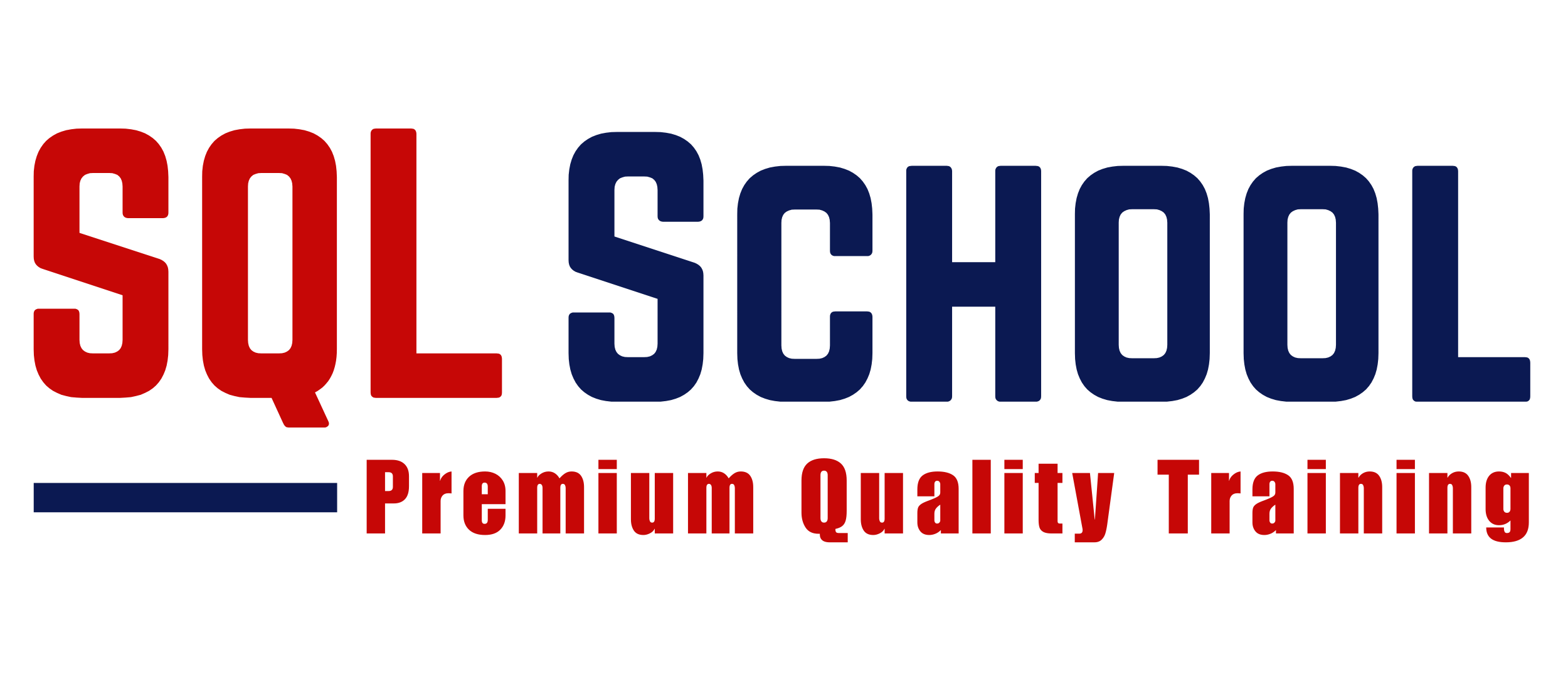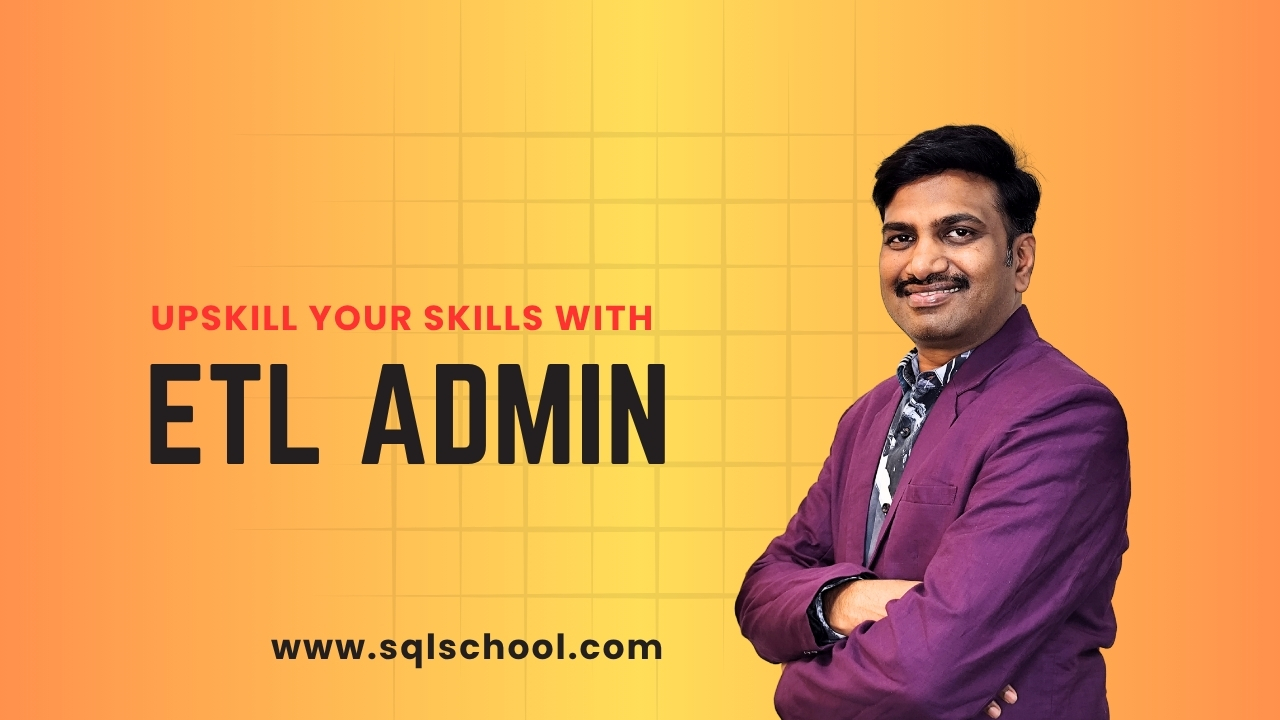
Cloud ETL Admin job roles are very prominent, high demand unique profile that involves End to End Database Management From OLTP to DWH Databases. This ETL Admin jobs are very much mandatory for Big Data, Data Science and AI Projects ! Practically speaking, we need DATA and every DATA Storage platform needs ADMIN.
✅ ETL Architecture & Data Flows
✅ SSIS, Informatica, Talend, ADF
✅ Scheduling & Job Monitoring
✅ Error Handling & Logging
✅ Performance Optimization
✅ Validation & Quality Checks
✅ Incremental Loads & CDC
✅ Cloud ETL Integrations
✅ Real Time Project
✅ 1:1 Mentorship, Resume
ETL Admin Training Contents:
Module 1 : Core SQL DBA
Ch 1: Introduction
- Database Introduction
- Types of Databases
- Need for Database Admins
- ETL Admin Job Roles
- Routine, Emergency DBA
- SQL Server Advantages
- Version, Editions of MSSQL
Ch 2: Installation
- SQL Server 2019, 2017
- SSMS Tools Installation
- Database Engine (OLTP)
- SCM, Configuration Tools
- Instance Types, Uses
- Authentication Modes
- Collation, File Stream
Ch 3: SQL BASICS – 1
- Need for Databases, Tables
- Need for SQL Commands
- DDL, DML & DQL Statements
- Database Creation @ GUI
- Data Operations @ GUI
- Session ID, SQL Context
- DB, Tables, Data @ SQL
Ch 4: SQL BASICS – 2
- DDL Variants in MSSQL
- DML Variants in MSSQL
- INSERT & INSERT INTO
- SELECT & SELECT INTO
- Basic Operators in SQL
- Special Operators in MSSQL
- ALTER, ADD, TRUNCATE, DROP
Ch 5: Data Imports, Schemas
- Data Imports with Excel
- ORDER BY & UNION
- UNION ALL For Sorting Data
- Creating, Using Schemas
- Real-world Banking Database
- Table Migrations @ Schemas
- 2 Part, 3 Part & 4 Part Naming
Ch 6 : Constraints, Index Basics
- Need for Constraints, Keys
- NULL, NOT NULL, UNIQUE
- Primary Key & Foreign Key
- RDBMS and ER Models
- Identity Property, Default
- Clustered Index, Primary Key
- Non Clustered Index, Unique
Ch 7: Joins & Views Basics
- JOINS: Purpose. Inner Joins
- Left / Right / Full Outer Joins
- Cross Joins, Query Tuning
- Creating & Using Views
- DML, SELECT with Views
- RLS : WITH CHECK OPTION
- System Views & Metadata
Ch 8: Functions(UDF), Data Types
- Using Functions in MSSQL
- Scalar Value Functions
- Inline & Multiline Functions
- Date & Time Functions
- String, Aggregate Functions
- Data Types : Integer, Char, Bit
- SQL Variant, Timestamp, Date
Ch 9: Stored Procedures,Models
- Stored Procedures & Usage
- Creating, Testing Procedures
- Encryption, Deferred Names
- SPs for Validations, Analysis
- System SPs, Recompilation
- Normal Forms & Types
- Data Models, Self-References
Ch 10: Triggers, Temp Tables
- Need for Triggers
- DDL & DML Triggers
- Using Memory Tables
- Data Replication, Automation
- Local & Global Temp Tables
- Testing & Using Temp Tables
- SELECT .. INTO & Bulk Loads
Ch 11: DB Architecture, Locks
- Planning VLDBs : Files, Sizing
- Filegroups, Extents & Types
- Log Files : VLF, Mini LSN
- Table Location, Performance
- Schemas, Transfer, Synonyms
- Transactions Types, Lock Hint
- Query Blocking Scenarios
Ch 12 : Cursors & CTEs, Links
- Cursors : Realtime Use
- Fetch & Access Cursor Rows
- CTEs for SELECT, DML
- CTEs: Scenarios & Tuning
- Linked Servers, Remote Joins
- Linked Servers: MSDTC, RPC
- Tuning Remote Queries
Ch 13: Backups
- Database Backups & Files
- Backup Types & Options
- DB, Filegroup, File Backups
- Copy Only Backups, Usage
- Partial Backups, Split Backups
- Mirror Backups, Verifications
- Checksum, ContinueOnError
Ch 14: Restores
- DB, Filegroups, File Restores
- GUI Restores: Limitations
- Partial / Piece-meal Restores
- Restoring & Online States
- Standby Mode Restores
- Point-In-Time (PITR) Restores
- FILELISTONLY, MOVE Options
Ch 15: Jobs, Maintenance
- Jobs & SQL Server Agent
- Job Steps & Schedules
- Maintenance Plans
- Backup Maintenance Options
- Job Notifications, Operators
- DB Mail Configurations
- Common Errors, Solutions
Ch 16: Security Management
- Security Objects Usage
- Creating Logins & Users
- Creating Roles, Add Principals
- Schema Level Security
- Object, Column Level Security
- Security Management Scripts
- Security Audit, Logon Failures
Ch 17: DB Migrations
- Creating Credentials
- Creating Proxies, Realtime Use
- Creating CDW Packages
- Database Detach – Attach
- SMO Migration Method
- DB Migration Schedules
- Detect, Fix Orphan Users
Ch 18: DB Health Checks, Repairs
- DBCC Commands in Realtime
- DBCC for Audits, Repairs
- MSDB Suspect Pages
- User Database Repairs
- Log Space Issues, Solutions
- TempDB Issues, Solutions
- Memory Issues, Solutions
Ch 19: Query Audits, Perfmon
- Query Performance Issues
- Reasons for Slow Queries
- Performance Tuning Options
- Performance Tuning Tools
- Query Store & History
- Activity Monitor, Perfmon
- DMVs & DMFs for Audits
Ch 20: Indexes & Tuning
- Indexes: Sort Locations
- Clustered & Online Indexes
- Non-Clustered, Columnstore
- Included Indexes in Realtime
- Filtered Indexes & Usage
- Covering Index & Selectivity
- Indexed Views (Materialized)
Ch 21: Partitions, Statistics
- Partition Implementations
- Partition Functions & Schemes
- Primary & Secondary Types
- Data Archival with Partitions
- Compression with Partitions
- Statistics: Realtime Use
- Index, Column Stats, Updates
Ch 22: Tuning Tools, Exec Plans
- Tuning Tools and Workloads
- Profiler Tool: Trace Files
- Trace Filters and Rollover
- DTA Tool Recommendations
- PDS, & Index Size, Index Scan
- Execution Plans, Index Seeks
- Query Cost Issues, Solutions
Ch 23: MOT & Temporal Tables
- Memory Optimized Tables
- Non-Clustered Primary Keys
- Stats Updates, Performance
- Temporal Tables in Realtime
- History Tracking & Testing
- Timestamp Columns Usage
- Tuning Stored Procedures
Ch 24: Locks & Isolation Levels
- Transactions & Locks
- Lock Types & Performance
- Lock Management Options
- Isolation Levels & TempDB
- Snapshots and Performance
- Deadlocks Simulations, Graphs
- Profiler Tool & LIVE Locks
Ch 25: HA DR @ Replication – 1
- Replication: Realtime Usage
- Replication Considerations
- Distributor Configurations
- Publisher and Subscriber
- Replication Types: Snapshot
- Transactional Replication
- Log Reader Agent & Usage
- Replication Monitor, Alerts
Ch 26: HA DR @ Replication – 2
- Merge Replication & Usage
- Peer – Peer Replication
- Peer to Peer Topology
- Push & Pull Subscriptions
- Conflict Detection, Avoidance
- Scripting Replication Agents
- Limitations with Replication
- Common Errors, Solutions
Ch 27: HA DR @ Log Shipping
- Log Shipping Configurations
- Primary, Secondary Servers
- Monitor Instance Selection
- Working with Network Shares
- LS Jobs: Backup, Copy, Restore
- NORECOVERY, STANDBY
- Manual Failover Process
- Common Errors, Solutions
Ch 28: HA DR @ DB Mirroring
- Database Mirroring Concepts
- Configuring Principal, Mirror
- Configure Witness, End Point
- Synchronous, Asynchronous
- Automated Failover Process
- Manual Failover, Monitoring
- Common Errors, Solutions
Ch 29: Updates, Upgrades
- Updates, Upgrades Planning
- Pre-Maintenance Checklist
- Updates Process, Verifications
- Upgrade Process, Verifications
- History Tracking & Testing
- System Database Rebuilds
- DAC: Dedicated Admin Console
Ch 30: SQL DBA Project Phase
- Routine DBA Activities
- Emergency DBA Activities
- Maintenance DBA Activities
- SLA – OLA Process
- Ticketing Tools
- 3rd Party Tools
- Common Errors & Solutions
Module 2: Azure SQL DBA
Ch 31: Cloud Basics, Azure Funda
- Cloud Fundamentals
- Cloud Concepts, Benefits
- IaaS, PaaS, SaaS Cloud Types
- Azure Cloud Concepts
- Azure Resources & Usage
- Azure Services & Purpose
- Azure Account & Subscription
Ch 32: Azure SQL Database
- Azure SQL Services
- Azure SQL Server Creation
- Azure SQL Databases
- Azure Firewall: Rules
- Test Connections from SSMS
- SSMS Tool: Test Connections
- ADS Tool: Installation, use
Ch 33: Azure SQL DB Migrations
- SQL DB Migration Options
- Data Migration Assistant: DMA
- DMA Tool, Migration Options
- On-Premises DB Export
- Azure SQL Database Import
- Azure Storage Account
- Linking SSMS with Azure
Ch 34: Azure SQL DB Licensing
- Azure SQL DB Licensing
- Per Database Licensing
- DTUs: Basic, Standard Types
- VPU and Plan Types
- DTU Versus VPU Licensing
- Elastic DTUs (eDTU) Usage
- Elastic Query Processing
Ch 35: Azure SQL DB Metrics
- Azure SQL DB Metrics
- CPU, Memory, Log Metrics
- Data File Metrics, Alerts
- Action Groups & Emails
- Query Performance Insight
- Automated Tuning Options
- Query Recommendations
36: Azure SQL DB Tuning, AI
- Automated Tuning Options
- Manual Tuning Options
- Server Level Tuning
- Database Level Tuning
- AI Search Service, Tuning
- AI Indexes and Practical Use
- Watermark Columns, Updates
Ch 37: Azure SQL DB Tuning, AI
- Azure Backups & Restores
- Automated Backups
- Backup Retention Options
- LTR, PITR & Differential
- Backup Audits from Portal
- Restores from SQL Server
- Restores from Azure Portal
- PITR Restores
Ch 38: Azure HA DR
- Azure HA DR Mechanisms
- Geo Replication
- Server Failover
- Primary & Secondary
- Manual Failover
- Automated Failover
- Multi Database Replication
- Data Sync with Hub, Agent
Ch 39: Azure Security
- Azure SQL DB Security
- Logins & Users in master
- Logins & Users in SQL DB
- Role Based Security
- RLS & Users without Logins
- Dynamic Data Masking
- Creating AD Users & IAM
- Implementing RBAC
Ch 40: Azure PaaS & Azure IaaS
- Azure PaaS: Operations
- Azure PaaS: Limitations
- Azure IaaS: Advantages
- Azure IaaS Components
- Azure Virtual Machines
- Capacity & Networking
- Disk & Memory Config.
Ch 41: Azure IaaS Concepts
- Azure Virtual Machines
- SQL Server with Azure VM
- Access Azure VM from SSMS
- Migrations from PaaS
- Migrations from On-Premise
- Azure Data Studio, VMs
- Comparing SSMS & ADS Tool
Ch 42: Azure VM
- Azure IaaS Implementation
- Configure Disk, Network
- Configure SQL Security
- CPU, Processor & IO
- IP & RDP Connections
- Testing SSMS Connections
- Migrating SQL DB to VM
Ch 43: Azure Clusters
- Azure Active Directory
- Azure AD DS Services
- Azure Networking Options
- Availability Groups, Usage
- Listeners and Realtime Use
- FSW: File Share Witness
- Azure PaaS: Limitations
Ch 44: SQL Clusters, Always-On
- Creating SQL Clusters
- Testing SQL Clusters
- Configure Always-On
- Testing, Using Always-On
- AOAG Implementation
- AOAG Monitoring Options
- Comparing Paas & IaaS
Ch 45: DP 300 Exam Guidance
- PBM: Policy Management
- Scripting Operations
- Database Configurations
- Server Configurations
- Examination Pattern
- Sample Questions, Answers
- Latest Samples
Module 3: ETL & DWH with Cloud Computing
Ch 1: ETL, DWH Introduction
- Database Introduction Data Warehouse (DWH)
- Data Engineering Work Flow
- Cloud Concepts: IaaS, PaaS
- SaaS & Azure Cloud Concepts
- Azure Resources & Groups
- Storage, ETL, IoT Resources
Ch 2: Azure Intro, Azure SQL
- Azure SQL Server, SQL DBA
- Azure SQL Database (OLTP)
- Azure SQL Pool (DWH)
- Connections from SSMS Tool
- Connections from ADS Tool
- Pause / Resume SQL Pool
- Source Data Configurations
Ch 3: Azure Synapse (DWH)
- Synapse Pool Architecture
- Control Node, Compute Node
- DMS & Partitioned Tables
- Creating Tables with TSQL
- Distributions: RR, Hash, Repl
- Big Data Loads with TQL
- Important DMFs & DMVs
Ch 4: Azure Data Factory (ADF)
- Need for ADF & Pipelines
- Linked Services & IRs
- Datasets, Pipelines, Triggers
- Copy Data Activity & CDT
- Data Loads Pipelines, DTUs
- Pipeline Monitoring, Edits
Ch 5: ADF Incremental Loads – 1
- File Incremental Loads
- Storage Account, Data Lake
- Binary Copy, Schema Drift
- Staging Concept in ADF
- DOCP, Logging & Consistency
- Polybase Concept & Tuning
Ch 6: ADF Incremental Loads – 2
- Implement SCD with ADF
- Self-Hosted IR: Realtime Use
- On-premise Data: Incr Loads
- Copy Method: Upsert, Keys
- Staging & ADF Optimizations
- Pipeline Runs, Activity IDs
Ch 7: ADF Data Flow – 1
- Data Flow Transformations
- Spark Clusters for Debugging
- Optimized Clusters, Preview
- Conditional Split, SELECT
- Sort, Union Transformations
- Pipelines with Data Flow
Ch 8: ADF Data Flow – 2
- Working with Multiple Tables
- Join Transform, Broadcast
- Row Filters, Column Filters
- Surrogate Keys, Derived Cols
- ETL Loads Dates, Sink Options
- Aggregated Data Loads
Ch 9: ADF Data Flow – 3
- Pivot Transformation
- Group By & Pivot Keys
- Column Pattern, Deduplicate
- Lookup, Cached Lookup
- Tuning Transformations
- Tuning Data Flow, Spark
Ch 10: Synapse Analytics – 1
- Azure Synapse Analytics
- Dedicated SQL Pools
- TSQL: Stored Procedures
- Synapse Pipelines, Tuning
- SP Activity in Pipelines, Jobs
- Comparing ADF & Synapse
Ch 11: Synapse Analytics – 2
- Serverless Pools in Synapse
- TSQL Scripts with Serverless
- ADLS Data Imports & ELT
- Synapse Aggregation, Analytics
- Synapse Optimizations
- Synapse Security & Logins
Ch 12: Synapse Analytics – 3
- Apache Spark Pool & Usage
- Synapse Analytics with Pools
- PySpark Staging, Aggregations
- Spark Queries & Python ETL
- Python Notebooks, Pipelines
- Integrating Python with DWH
Ch 13: Parameters, SCD & ETL
- ADF Templates in Realtime
- Table Incremental Loads
- Control Tables, Watermarks
- Pipeline Parameters, SPs
- Dynamic Data Sets, SCD
Ch 14: CDC @ ETL, ELT & Tuning
- Using CDC in ADF
- Control Tables (CT): Upserts
- Handling Inserts, Updates
- SCD Type 1 & Type 2
- ADF, Synapse: Limitations
Ch 15: Azure Intro & Storage
- Storage, ETL, IoT Resources
- Azure Storage Components
- Azure Storage Account, HNS
- Azure Data Lake Storage
- Azure Storage Explorer Tool
- Storage Explorer Config
- Storage Account Properties
Ch 16: Azure Storage Operations
- BLOB Storage: Containers
- Storage Browser, Explorer
- File & Folder Uploads, Edits
- Azure Tables: Row Key
- Partition Key, Timestamp
- Use Cases of BLOB Storage
- Use Cases of Azure Tables
17: Azure Storage Security
- Realtime use of Keys
- Access Keys & Admin Access
- SAS Keys Generation, Ips
- Creating, Using Entra Users
- Azure AD Users, Groups
- IAM & RBAC with Entra Users
- ACLs and ADLS Security
Ch 18: Azure SQL DB Migrations
- On-Premise SQL DB bacpac
- Azure SQL Deployment
- Azure Storage from SSMS
- Azure SQL DB Migration
- Migration Verifications
- Testing Migrations in SQL
Ch 19: Azure Stream Analytics
- Azure IoT Hubs & Devices
- APIs with Connection Strings
- Azure Steam Analytic Jobs
- Inputs, Outputs, SAQL Query
- LIVE Feed: JSON, AVRO Files
- Watermark & LIVE Stats
Ch 20: Azure Stream Analytics
- Azure IoT Hubs & Devices
- APIs with Connection Strings
- Azure Steam Analytic Jobs
- Inputs, Outputs, SAQL Query
- LIVE Feed: JSON, AVRO Files
- Watermark & LIVE Stats
Ch 21: Azure Key Vaults, Alerts
- Azure Encryptions @ REST
- Azure Key Vaults & Keys
- SMK & CMK Encryptions
- Azure Metrics: Ingress
- Egress, E2E Latency Issues
- Performance Tuning Options
Ch 22: Azure Storage Optimization
- BLOB Types & Content Types
- Hot, Cool, Cold, Archive Types
- Creating, Using Access Policies
- Immutable Storage, Rotation
- Containerization, Indexing
- Replication: LRS, ZRS, RA-GRS
Ch 23: Azure Pricing, Functions
- Azure Logic Apps: Usage
- Log Apps Usage in ETL
- Snapshots, Azure Functions
- Azure Functions Realtime Use
- ETL & DWH with Functions
- Azure Resource Pricing
Ch 24: Azure Big Data & Spark
- Azure Big Data & Spark
- Azure ETL & DWH Databases
- Azure Spark, HIVE Metastore
- Azure Databricks Service
- Spark Cluster (Personal)
- Unity Catalog & Azure VM
Ch 25: Spark Cluster Operations
- DBFS: Flat File Imports
- Table Conversions using GUI
- Spark Clusters: Table Creations
- Basic Transformations in Spark
- SQL Notebooks: Creation
- Default DB Queries, Cloning
Ch 26: Python & PySpark, ETL
- Python Fundamentals
- Python Data frames: ETL
- Python for Big Data, Pandas
- Python Notebooks, Views
- Aggregated Loads to Spark
- Spark DB Creations, Tables
Ch 27: PySpark & ADLS, Widgets
- Creating Spark Databases
- Spark Tables, Catalog Info
- PySpark with ADLS Storage
- Using Widgets for ADLS Keys
- PySpark Variables & Widgets
- Using Variables in Functions
- Spark SQL with Control Text
- Using Variables in Spark SQL
Ch 28: ADB Jobs, Delta Tables
- Azure Databrick Jobs
- Azure Workflows & Tasks
- Notebook Schedule Options
- Continuous Jobs, Notifications
- Delta Tables & Data Cleansing
- SCD (Merge Into), Contact, etc.
- Creating, Using Data frames
- Multi Data frame Joins
Ch 29: Scala Notebooks & ETL
- Scala Notebooks: Purpose
- Aggregated Data Loads
- Incremental Data Loads
- Widgets & Jobs with Scala
- Python Versus Scala
- Converting Python to Scala
- JVM Benefits, SQL DB Conn”
- SQL DB Loads with Scala
Ch 30: Databricks Architecture
- Azure Databricks Services
- Cluster Components & DBFS
- RDD, DAG, Photon, Spotlight
- Spark Partitioned Tables
- Cluster Manager: Spark Jobs
- Databricks Runtime (DBR)
- Databricks Security
- Workspace Security
- Notebook & Job Security
Ch 31: Medallion Architecture
- Medallion Architecture in ETL
- DWH Data Loads & Incr Loads
- Bronze, Silver & Gold Data
- Processing Raw Data Files
- Data Cleansing, Formatting
- Aggregation Advantages
- DBES & Node Architecture
- Unity Catalog Concept
- LUNs and Unity Catalog
Ch 32: Delta LIVE Tables (DLT)
- Creating Delta LIVE Tables
- DLT Pipelines in ETL, DWH
- Automated Incr Loads
- Control Tables, Timestamp
- SCD Type 1 with DLT
- SCD Type 2 with DLT
- Automated Merge Into Stmt
- Delta Tables Vs DLT
- Merge Into Vs DLT Pipeline
SQL SCHOOL
24x7 LIVE Online Server (Lab) with Real-time Databases.
Course includes ONE Real-time Project.
ETL Admin Training FAQs
What is ETL Admin Job Role?
ETL Stands for Extract, Transfer and Load.
It refers to Data Extraction from various sources of data (Apps, Files, Databases, Forms, IoT Devices, etc..), Transformation or data mashup operations and Big Data Loads.
What are the Job Roles of an ETL Admin?
- Managing Big Data & ETL
- Managing IAM [Identity & Access Management]
- Managing Data Warehouse (DWH) Databases
- Secure & Optimize Data Warehouse (DWH)
- Orchestrate the Data Flow
- Data Governance, Policy Management and more .. !
What does our ETL Admin Training course contains?
The course is carefully curated with below modules:
👉🏻Module 1: SQL Database & Core SQL DBA
👉🏻Module 2: Azure SQL DBA
👉🏻Module 3: Azure Data Engineer / Fabric Data Engineer [You may choose any one]
👉🏻Module 4: ETL Admin Concepts with Big Data, Spark, Synapse / Fabric DWH
Who can join this course?
Any one can join this course. Preferably for folks who wanted to show some technical expertise in their resume..
What training modes are available?
Option 1: LIVE Online Training (100% Interactive, step by step, assignments)
Option 2: Self Paced Videos (100% practical, step by step with concept wise assignments)
You may choose any one of these options, same curriculum!
I (Trainer) shall be available for doubts and clarifications, assignment check and review.
Why should I choose SQL School for ETL Admin training?
👉🏻 Every session is Practical, Step by Step with Concept wise FAQs !!
👉🏻 100% results with on-time practice. Daily Tasks for every session.
👉🏻 Concept wise tasks be submitted before next class for Job Waiters / Starters.
👉🏻 Concept wise tasks due for submission by Weekends for Working Professionals.
#Top Technologies
Why Choose SQL School
- 100% Real-Time and Practical
- ISO 9001:2008 Certified
- Concept wise FAQs
- TWO Real-time Case Studies, One Project
- Weekly Mock Interviews
- 24/7 LIVE Server Access
- Realtime Project FAQs
- Course Completion Certificate
- Placement Assistance
- Job Support
- Realtime Project Solution
- MS Certification Guidance
















